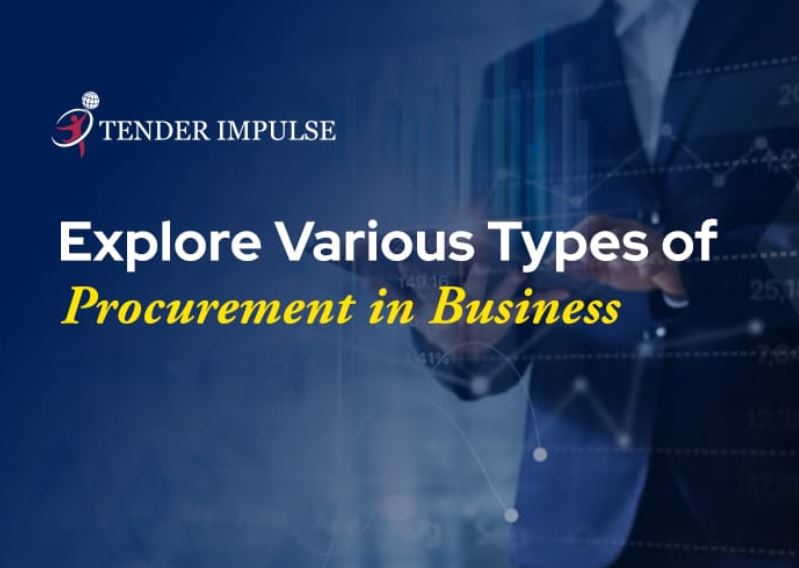Explore Various Types of Procurement in Business
Success in the fast-paced corporate world of today depends on knowledge of procurement in the business scene. Many businesses are turning more and more to cutting-edge skills to simplify their operations. Tender Impulse is one such platform that transforms how companies handle their purchasing requirements. This blog will explore the several forms of procurement and emphasize the use of e-procurement process in improving efficiency.
Understanding Procurement in Business
Procurement in business is the process of obtaining products and services required for operations. It includes finding needs, recruiting vendors, contract negotiation, and supplier relationship management. Among the many kinds of procurement methods are direct procurement, indirect procurement, and services procurement. Every kind has different goals and calls for different methods.
Direct Procurement
Direct procurement is the acquisition of items and raw materials absolutely required for manufacturing. To keep production timelines and satisfy consumer needs, businesses often participate in direct buying. Efficient administration of this kind of purchasing may result in significant cost reductions and enhanced operational effectiveness. To simplify these procedures, companies usually use an e procurement portal, which helps to improve inventory control and monitoring.
Key Elements of Direct Procurement
- Supplier Relationships: Ensuring prompt delivery and quality depends on good supplier relationships.
- Cost Management: To enhance profitability, companies have to constantly evaluate the expenses related to direct purchasing.
- Inventory Control: Maintaining appropriate inventory levels helps to avoid stockouts and excess situations.
Indirect Procurement
It refers to the investment in products and benefits that are not directly related to manufacturing but rather required for the general operation of a company. This covers additional operating needs, maintenance services, and office supplies. Often complicated, the e-procurement system for indirect purchases calls for thorough research and smart sourcing.
Strategies for Effective Indirect Procurement
- Spend Analysis: Examining expenditure trends helps companies find places for cost reduction.
- Supplier Diversification: Using many providers helps to offset the dangers of depending on one source.
- Expertise Utilization: Using e-procurement solutions helps to simplify procedures and increase visibility.
Services Procurement
Service procurement emphasizes obtaining services instead of tangible goods. This could include professional services, IT support, and consulting services. To guarantee quality and value, businesses must properly control these ties. An e-procurement portal may help to enable this by offering platforms for service-level agreements and vendor management.
E Procurement Solutions
Scientific advancement in purchasing has given birth to e procurement solutions. These digital solutions simplify the procurement process, therefore increasing its efficiency and openness. Informed decisions and stronger supplier relationships may follow for organizations with more insight into their purchasing operations.
The E-Procurement Process
Usually, the e-procurement process has multiple steps:
- Needs Identification: Realizing what services or products are needed.
- Supplier Selection: Choosing a supplier means finding and assessing possible ones.
- Placing Orders: Sending purchase orders using the e-procurement system.
- Goods Receipt: Verifying the arrival of services or products.
- Processing invoices: Overseeing payments and verifying invoicing correctness.
Following this methodical process helps companies to make the most of their purchasing efforts.
Tendering Portals
The utilization of tendering portals is another important factor in purchasing. These let companies post their purchasing requirements and get supplier offers. This competitive bidding system guarantees that businesses get the finest options available.
How Tendering Portals Work
- Tenders’ advertisement: Companies publish their portal-based purchasing requirements.
- Supplier Responses: Suppliers submit their bids electronically.
- Evaluation: Companies evaluate all submissions based on predefined criteria.
- Awarding Contracts: The best bid is selected, and contracts are awarded.
Tendering portals streamline the purchasing process and improve openness, hence helping companies to choose the appropriate vendors.
Challenges in Procurement
Though e-procurement and tendering portals have benefits, companies struggle with their procurement in corporate strategy in many ways:
- Integration Issues: Including new expertise into current systems could be difficult and time-consuming.
- Supplier Resistance: Certain vendors can be reluctant to use new digital platforms.
- Data Security: Protecting sensitive procurement data is a major worry.
Businesses have to spend money on training and service for their workers and suppliers if they are to negotiate these difficulties.
The Role of Tender Impulse in Modern Procurement
By offering creative mechanical solutions that improve e-procurement process, Tender Impulse helps to meet these difficulties significantly. Using its features, companies may strengthen their purchasing plans, thus guaranteeing their competitiveness in an always-changing market.
How Tender Impulse Enhances Procurement
- Simplified Procedures: The knowledge automates certain procurement activities, hence lowering human effort.
- Data Analytics: Insights from procurement data help to improve decision-making.
- Supplier Management: Improved systems help to promote greater supplier communication and cooperation.
Best Practices for Effective Procurement
Organizations should follow the following best practices if they want to realize the advantages of procurement in business:
- Conduct Routine Audits: Regularly review procurement procedures to see inefficiencies and opportunities for growth.
- Support in Training: Make sure procurement staff are well-versed in utilizing e-procurement process and best practices.
- Promote cooperation: Urge interdepartmental communication to guarantee consistency in procurement plans.
- Leverage Skill: Use the most recent platform, like Tender Impulse, to improve purchasing capacity.
Future Trends in Procurement
Several developments will influence the future of procurement as skill develops:
- Increased Automation: More companies will look to automation to simplify procurement procedures and save expenses.
- Sustainability Focus: Procurement policies will give sustainability and ethical sources more and more first priority.
- Digital Transformation: Processes will be more efficient and open as the move toward digital procurement solutions continues.
- Data-Driven Decision Making: Companies will more and more depend on data analytics to guide supplier selection and procurement strategy.
Operational performance in a company depends on knowledge of the many kinds of procurement. E-procurement systems help companies improve supplier relationships and simplify their procedures. The future of purchasing will be shaped more and more by the incorporation of platform such as Tender Impulse, which will also make it more efficient and effective. Those who welcome these innovations will be better able to succeed in today’s competitive scene. Organizations should make sure their procurement plans remain strong and flexible by concentrating on best practices and keeping ahead of future trends.





